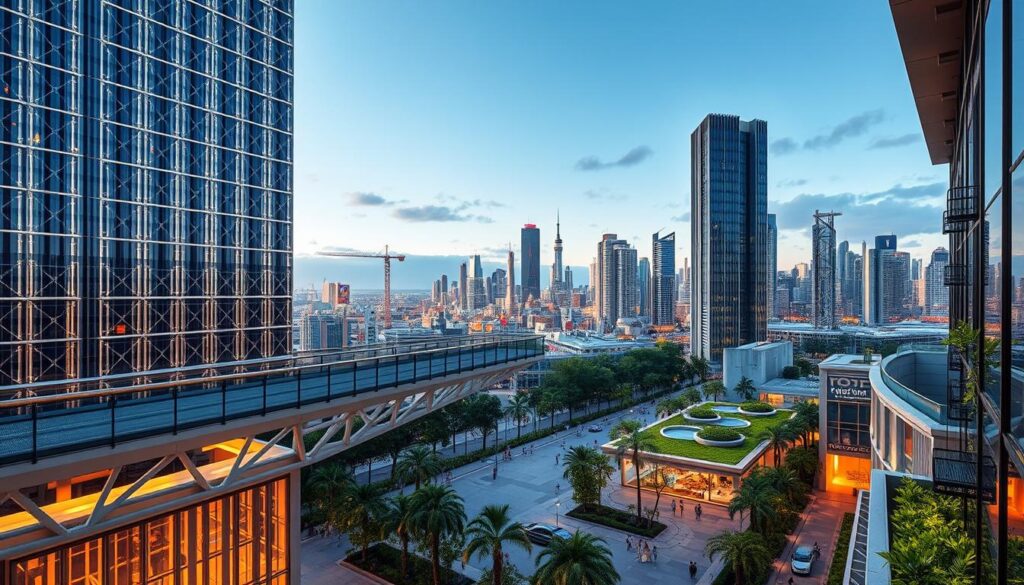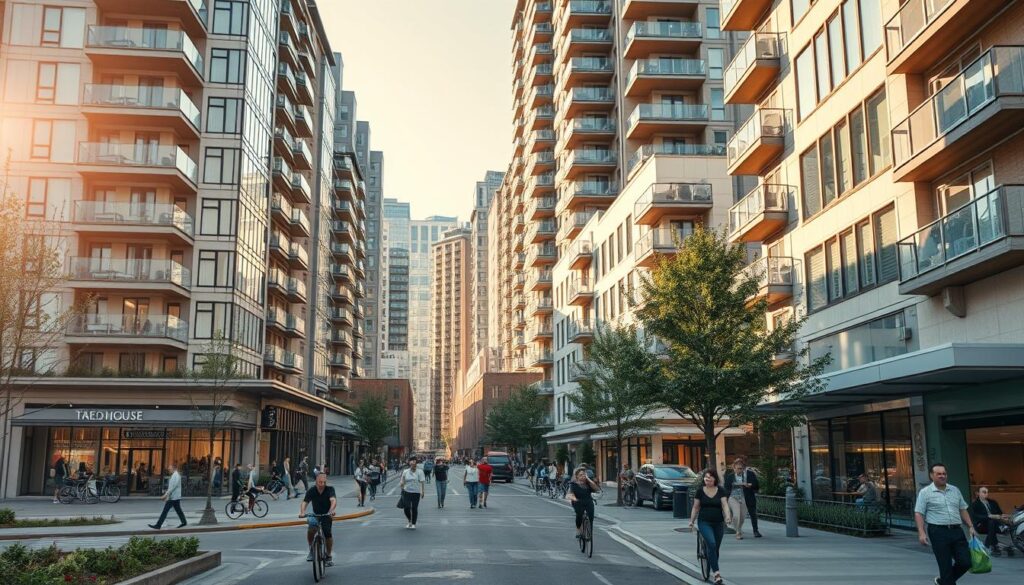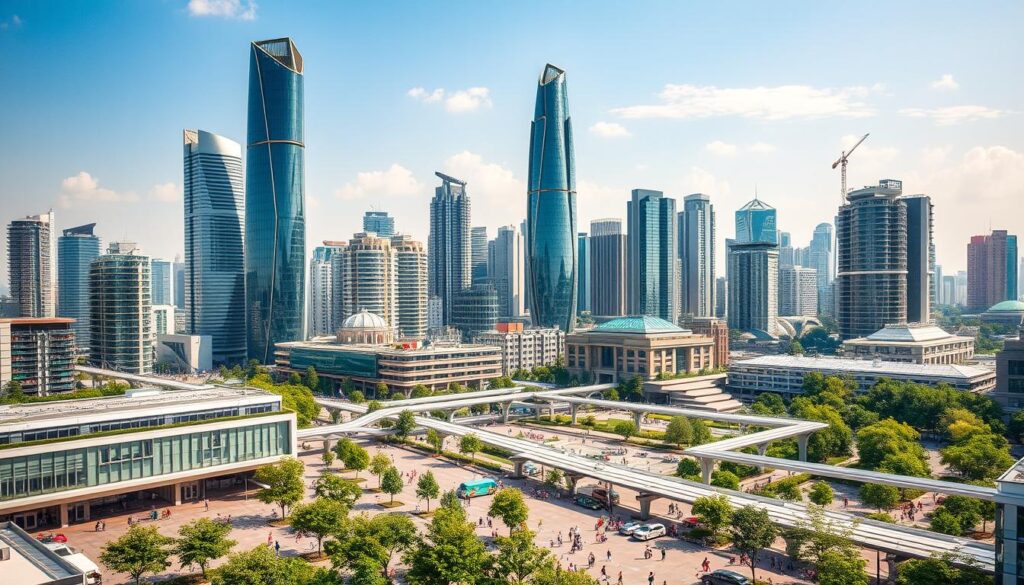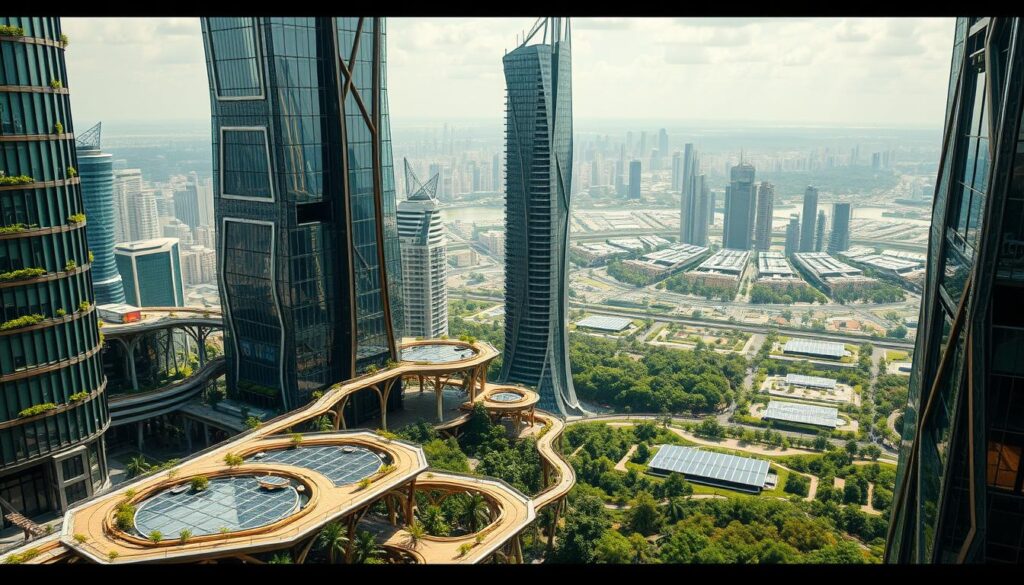The United States is experiencing a significant transformation in its urban landscapes, driven by the adoption of sustainable urban construction methods. As cities grow, the need for environmentally responsible building practices becomes increasingly important. In fact, the USA is witnessing a surge in the use of innovative construction techniques that not only enhance urban development but also reduce environmental impact.
By embracing modern construction techniques, the USA is able to improve energy efficiency, reduce waste, and create more livable cities. For instance, methods like prefabrication and modular construction are being increasingly used, as highlighted in guides on cutting construction costs, which can significantly reduce construction time and costs.
Key Takeaways
- Innovative construction techniques are transforming urban development in the USA.
- Sustainable urban construction methods are reducing environmental impact.
- Modern construction techniques are improving energy efficiency and reducing waste.
- Prefabrication and modular construction are becoming increasingly popular.
- These methods are contributing to more livable and sustainable cities.
Overview of Modern Construction Techniques
Modern construction techniques are revolutionizing the way cities are built and developed. Innovative building techniques are playing a crucial role in shaping modern urban environments. These advancements prioritize precision, safety, and interdisciplinary collaboration, leading to more efficient and sustainable construction practices.
Building Information Modeling (BIM) is a significant enhancement in modern construction, improving design precision and project management efficacy. By leveraging BIM, construction projects can reduce errors, minimize waste, and optimize resource allocation.
Importance in Urban Development
Modern construction techniques are crucial for urban development as they enable the creation of infrastructure that meets the growing demands of urban populations. These techniques facilitate the development of sustainable, resilient, and adaptable cities.
For instance, the use of innovative construction methods can significantly enhance the quality of urban living by providing efficient transportation systems, green spaces, and energy-efficient buildings.
Economic Benefits to Cities
The adoption of modern construction techniques offers numerous economic benefits to cities. These include reduced construction time and costs, improved project quality, and enhanced property values.
| Economic Benefits | Description | Impact |
|---|---|---|
| Reduced Construction Time | Streamlined processes and efficient project management | Earlier completion and occupancy |
| Cost Savings | Minimized waste and optimized resource allocation | Lower overall project costs |
| Improved Project Quality | Enhanced design precision and construction techniques | Better quality infrastructure and buildings |
Environmental Considerations
Modern construction techniques also address environmental considerations by promoting sustainable practices and reducing the ecological footprint of construction projects. The use of eco-friendly materials, energy-efficient designs, and waste reduction strategies are key aspects of environmentally responsible construction.
By incorporating green building practices and sustainable materials, cities can reduce their environmental impact while creating healthier and more sustainable urban environments.
Innovative Materials Transforming Urban Spaces

Innovative materials are revolutionizing urban development by providing sustainable and efficient construction solutions. These materials are not only reducing the environmental impact of construction but also enhancing the functionality and energy efficiency of buildings.
Sustainable Building Materials
Sustainable building materials, such as recycled steel and reclaimed wood, are gaining popularity in urban construction. These materials reduce resource consumption while maintaining structural strength. Other materials like insulated concrete forms provide excellent thermal insulation, reducing the need for heating and cooling.
- Recycled steel reduces waste and conserves natural resources.
- Reclaimed wood adds character to buildings while promoting sustainability.
- Insulated concrete forms enhance energy efficiency.
Smart Materials in Construction
Smart materials are another innovation transforming urban spaces. Materials like aerogels and phase-change substances optimize insulation and energy efficiency. For more information on the latest technologies in construction, visit World Civil Society.
- Aerogels provide superior insulation due to their unique structure.
- Phase-change materials help regulate building temperatures.
The integration of these innovative materials is crucial for creating healthier and more sustainable urban environments. As urban development continues to evolve, the use of sustainable and smart materials will play a significant role in shaping the cities of the future.
Modular Construction: A Revolution in Urban Building
Urban building is undergoing a revolution, thanks to the efficiency and sustainability of modular construction. This innovative method involves assembling building components in a factory, away from the construction site, before transporting them to the site for final assembly.
Benefits of Modular Construction
Modular construction offers several advantages over traditional construction methods. These include:
- Reduced Construction Time: Modular construction can significantly cut down the time required to complete a project.
- Improved Quality Control: Components are manufactured in a controlled environment, ensuring higher quality.
- Enhanced Safety: With a significant portion of the work done in a factory, the risk of accidents on the construction site is reduced.
The benefits of modular construction are further highlighted in the following table:
| Benefit | Description | Impact |
|---|---|---|
| Speed | Faster assembly and completion | Reduced project timelines |
| Quality | Controlled manufacturing environment | Higher quality components |
| Safety | Reduced on-site labor | Lower risk of accidents |
Key Players in the Industry
Several companies are at the forefront of modular construction, driving innovation and adoption. Some of the key players include:
- Red Sea Global
- Katerra
- Clayton Homes
These companies are pushing the boundaries of what is possible with modular construction, investing in research and development to improve efficiency and sustainability.
3D Printing: Shaping the Future of Urban Construction

The advent of 3D printing technology is revolutionizing urban construction by enabling the creation of complex structures with unprecedented precision. This cutting-edge building technology is transforming the way cities are developed, from Tokyo to London, and beyond.
Currently, 3D printing is being utilized in various urban development projects, showcasing its potential to customize and precision-craft building components. For instance, it is being used to produce bespoke facade details and intricate plumbing systems, enhancing the aesthetic and functional aspects of buildings.
Current Applications in Urban Development
One of the significant advantages of 3D printing in urban construction is its ability to create complex geometries and designs that would be difficult or impossible to achieve with traditional construction methods. This capability is being leveraged in various applications, including:
- Customized building facades that enhance the visual appeal of urban landscapes.
- Intricate architectural features that add uniqueness to building designs.
- Complex plumbing and piping systems that improve the efficiency and sustainability of buildings.
For more insights on how 3D printing is shaping urban planning, visit Urban Design Lab to explore the latest developments in this field.
Challenges and Limitations
Despite its promising applications, 3D printing in urban construction faces several challenges and limitations. These include high initial investment costs, limited scalability, and the need for specialized labor and equipment. Addressing these challenges is crucial to fully harnessing the potential of 3D printing in urban development.
As the technology continues to evolve, it is expected that these limitations will be mitigated, paving the way for more widespread adoption of 3D printing in urban construction projects. The future of urban development is likely to be significantly influenced by such cutting-edge technologies, leading to more sustainable, efficient, and innovative building practices.
Green Building Practices in Urban Areas
As urban areas continue to grow, the importance of green building practices cannot be overstated. These practices are crucial for reducing the environmental impact of urban development and creating sustainable cities.
One key aspect of green building practices is LEED certification. LEED, or Leadership in Energy and Environmental Design, is a widely recognized standard for measuring a building’s sustainability. Buildings that achieve LEED certification have demonstrated a commitment to energy efficiency, water conservation, and reducing their environmental footprint. For more information on LEED certification and its benefits, visit https://www.pnnl.gov/explainer-articles/green-buildings.
LEED Certification and Urban Development
LEED certification plays a significant role in urban development by promoting sustainable building practices. It encourages developers to adopt energy-efficient designs and materials, reducing the overall environmental impact of their projects.
| LEED Certification Level | Points Required | Benefits |
|---|---|---|
| Certified | 40-49 | Basic level of sustainability achievement |
| Silver | 50-59 | Moderate level of sustainability achievement |
| Gold | 60-79 | High level of sustainability achievement |
| Platinum | 80+ | Highest level of sustainability achievement |
Energy-Efficient Designs
Energy-efficient designs are another critical component of green building practices. These designs focus on minimizing energy consumption while maximizing comfort and productivity. Techniques include using advanced insulation materials, optimizing natural lighting, and incorporating renewable energy sources like solar and wind power.
By adopting energy-efficient designs, buildings can significantly reduce their energy consumption, leading to cost savings and a reduced carbon footprint. This not only benefits the environment but also enhances the health and well-being of occupants.
In conclusion, green building practices, including LEED certification and energy-efficient designs, are essential for creating sustainable urban environments. By adopting these practices, cities can reduce their environmental impact and promote a healthier, more sustainable future for their residents.
Smart City Technologies in Construction

Smart city technologies are transforming the way we approach construction projects, making them more efficient and sustainable. These technologies are crucial in creating urban environments that are not only livable but also environmentally friendly.
Integration of IoT in Building Projects
The Internet of Things (IoT) is playing a pivotal role in modern construction by enabling real-time monitoring and control of building systems. Smart buildings equipped with IoT devices and sensors can optimize energy efficiency, enhance security, and improve occupant comfort. For instance, IoT sensors can monitor and adjust lighting, heating, and cooling systems based on occupancy and environmental conditions.
Some of the key benefits of integrating IoT in building projects include:
- Enhanced energy efficiency through real-time monitoring and adjustments.
- Improved security through advanced surveillance and access control systems.
- Better occupant comfort through personalized climate and lighting controls.
For more information on the role of smart cities in future urban planning, visit The Role of Smart Cities.
Enhancing Urban Infrastructure
Smart city technologies are not only transforming individual buildings but also enhancing urban infrastructure as a whole. By integrating data from various sources, cities can optimize traffic flow, manage waste more effectively, and provide better public services. Smart city construction approaches are being adopted worldwide to create more sustainable and resilient urban environments.
Some of the ways smart city technologies are enhancing urban infrastructure include:
- Optimizing traffic management through real-time data analysis.
- Implementing smart grids for more efficient energy distribution.
- Enhancing public safety through advanced surveillance systems.
To learn more about sustainable building materials, check out Sustainable Building Materials.
Prefabrication and Its Role in City Planning
City planning is being redefined through the use of prefabricated elements, enhancing the speed and cost-effectiveness of construction projects. Prefabrication involves manufacturing building components off-site and assembling them on-site, which streamlines the construction process.
Streamlining Construction with Prefabrication
The use of prefabricated elements significantly reduces the time required for construction. By manufacturing components off-site, the on-site assembly process becomes much faster and more efficient.
Speed of Construction
The speed of construction is one of the primary advantages of prefabrication. Since the components are manufactured off-site, weather conditions and other on-site factors do not hinder the production process.
- Reduced on-site labor costs
- Faster assembly times
- Improved quality control
Case Study: Prefabrication in Action
A notable example of prefabrication’s success is seen in modular housing projects, where entire rooms are constructed off-site and assembled on-site, significantly reducing construction time.
Cost-Effectiveness of Prefabricated Elements
Prefabrication not only speeds up the construction process but also improves cost-effectiveness. By reducing labor costs and minimizing waste, prefabricated elements offer a financially viable solution for urban development projects.
| Benefits | Description | Impact |
|---|---|---|
| Reduced Labor Costs | Less labor required on-site | Cost savings |
| Minimized Waste | Precise manufacturing reduces material waste | Environmental benefits |
| Faster Construction | Off-site manufacturing and on-site assembly | Quicker project completion |
In conclusion, prefabrication is playing a vital role in city planning by enhancing the speed and cost-effectiveness of construction projects. As urban development continues to evolve, the use of prefabricated elements is expected to become increasingly prominent.
Urban Infill Development Techniques

Urban infill development is a key strategy for creating more livable, sustainable cities by optimizing the use of existing urban land. This approach focuses on revitalizing underutilized or abandoned areas within cities, thereby reducing urban sprawl and promoting more efficient use of resources.
Maximizing Land Use
Maximizing land use is a critical aspect of urban infill development. By converting vacant lots, underused buildings, or other urban spaces into functional areas, cities can increase their density and reduce the pressure on peripheral lands. Effective land use planning involves assessing the potential of urban parcels and identifying opportunities for redevelopment.
Urban infill projects can range from small-scale interventions, such as community gardens or pocket parks, to large-scale developments, including mixed-use buildings or entertainment complexes. The key is to ensure that these projects align with the city’s overall development strategy and meet the needs of the local community.
Case Studies of Successful Infill Projects
Several cities have successfully implemented urban infill development projects, providing valuable lessons and insights. For instance, the redevelopment of the Hudson Yards in New York City is a notable example of large-scale infill development. This project transformed a former industrial area into a vibrant mixed-use district, featuring office spaces, residential units, and public amenities.
“Urban infill development is not just about filling in the gaps; it’s about creating vibrant, livable spaces that enhance the quality of life for urban residents.” – Urban Planning Expert
| City | Project | Description |
|---|---|---|
| New York City | Hudson Yards | Large-scale mixed-use development on a former industrial site |
| Chicago | Maggie Daley Park | Conversion of an old rail yard into a unique public park |
| San Francisco | Transbay Transit Center | Revitalization of the Transbay area with a new transit center and surrounding development |
Role of Drones in Modern Urban Construction
Drones are transforming urban construction by providing unprecedented aerial insights. This technology has become a game-changer in the construction industry, offering a range of benefits that enhance the efficiency, safety, and cost-effectiveness of urban development projects.
The integration of drones into urban construction is multifaceted, with applications ranging from site surveying and mapping to safety monitoring and inspections. By leveraging drone technology, construction companies can gain a competitive edge in the market.
Site Surveying and Mapping
One of the primary uses of drones in urban construction is for site surveying and mapping. Drones equipped with high-resolution cameras and sensors can capture detailed aerial data, which is then used to create accurate topographic maps and 3D models of the construction site.
This information is invaluable for project planning, allowing developers to assess the site’s conditions, identify potential challenges, and make informed decisions about the project’s progression. For more insights on how drones are used in urban planning, visit Flyby Guys’ blog on urban planning with.
| Benefits of Drone Surveying | Traditional Surveying Methods | Drone-Based Surveying |
|---|---|---|
| Accuracy | High | Very High |
| Cost | Expensive | Cost-Effective |
| Time | Time-Consuming | Rapid Data Collection |
Safety Monitoring and Inspections
Drones also play a crucial role in safety monitoring and inspections during urban construction projects. By conducting regular aerial surveys, drones can help identify potential safety hazards, such as structural damage or unsafe working practices.
This proactive approach to safety monitoring enables construction companies to address issues before they become major problems, reducing the risk of accidents and improving overall site safety.
- Enhanced Safety: Drones help in identifying potential hazards early.
- Increased Efficiency: Regular inspections can be conducted quickly and effectively.
- Cost Savings: Reducing the need for manual inspections saves time and resources.
Advanced Project Management Techniques

In the realm of urban construction, advanced project management techniques are becoming increasingly crucial. These techniques enable project managers to oversee complex construction projects more effectively, ensuring timely completion, cost efficiency, and high-quality outcomes.
Agile Methodology in Construction
The adoption of Agile methodology in construction projects is enhancing flexibility and collaboration among project stakeholders. Agile allows for iterative progress, continuous improvement, and flexibility in response to change. This methodology is particularly beneficial in urban construction, where projects often involve multiple stakeholders and complex logistical challenges.
By embracing Agile, construction teams can better manage project uncertainties and improve overall project delivery. For instance, regular sprint meetings and retrospectives help teams stay aligned and address issues promptly. To learn more about how Agile is transforming construction project management, visit World Civil Society.
Use of Construction Management Software
The use of construction management software is another critical aspect of advanced project management in urban construction. This software facilitates project scheduling, cost estimation, quality control, and communication among stakeholders. By leveraging technology, project managers can streamline processes, reduce errors, and enhance collaboration.
A comparison of different construction management software tools is provided in the table below:
| Software | Key Features | Benefits |
|---|---|---|
| Procore | Project scheduling, quality control, RFIs | Enhanced collaboration, real-time updates |
| Autodesk Construction Cloud | Project management, document control, BIM | Improved accuracy, streamlined workflows |
| PlanGrid | Document management, field reporting, RFIs | Increased productivity, reduced errors |
By adopting advanced project management techniques, such as Agile methodology and construction management software, urban construction projects can achieve greater efficiency, reduced costs, and improved outcomes. These innovations are pivotal in shaping the future of urban development.
Collaborative Approaches in Urban Construction
Collaborative approaches are transforming the urban construction landscape by emphasizing stakeholder engagement and leveraging public-private partnerships. This integrated approach is enhancing project delivery and outcomes by fostering collaboration and reducing risks.
Stakeholder Engagement
Effective stakeholder engagement is crucial in urban construction projects. It involves identifying and engaging with various stakeholders, including local communities, government agencies, and private developers. By doing so, projects can better address community needs and concerns, leading to more successful outcomes.
Design-build construction is an example of an integrated approach that combines design and construction phases, enhancing collaboration and reducing risks. According to a study published on SpringerLink, such collaborative approaches can significantly improve project efficiency.
Benefits of Public-Private Partnerships
Public-private partnerships (PPPs) offer numerous benefits in urban construction, including improved project financing, enhanced technical expertise, and better risk management. PPPs facilitate the sharing of resources and expertise between public and private sectors, leading to more efficient and effective project delivery.
- Increased efficiency through shared resources
- Improved project financing through private investment
- Enhanced technical expertise from private sector partners
By adopting collaborative approaches and leveraging public-private partnerships, urban construction projects can achieve better outcomes, improve stakeholder satisfaction, and contribute to the development of smart cities.
Future Trends in Urban Construction Techniques

Future trends in urban construction techniques are revolutionizing the way cities are developed. As urban populations continue to grow, the need for innovative and sustainable construction methods becomes increasingly important.
The integration of technology in urban construction is not just a trend; it’s a necessity. With the help of advanced technologies, cities can become more efficient, sustainable, and resilient.
Predictive Analytics and Big Data
Predictive analytics and big data are transforming the urban construction landscape. By analyzing vast amounts of data, construction companies can predict potential delays, manage resources more effectively, and improve project outcomes.
The use of predictive analytics allows for better decision-making and risk management. For instance, data analytics can help identify potential bottlenecks in the construction process, enabling proactive measures to mitigate these issues.
| Technology | Application | Benefit |
|---|---|---|
| Predictive Analytics | Project Management | Improved Efficiency |
| Big Data | Resource Allocation | Cost Reduction |
| IoT Integration | Real-time Monitoring | Enhanced Safety |
Resilient Urban Design Principles
Resilient urban design principles are crucial in creating sustainable and adaptable urban environments. These principles focus on designing cities that can withstand and recover from natural disasters and other challenges.
By incorporating resilient design principles, cities can reduce the impact of adverse events and improve the quality of life for their residents. This includes designing buildings and infrastructure that are adaptable and can evolve with the needs of the city.
The future of urban construction is not just about building structures; it’s about creating resilient, sustainable, and thriving cities. By embracing future trends and innovative techniques, we can build a better tomorrow for urban populations.
Conclusion: The Future of Urban Development in the USA
The US civil engineering sector is undergoing a significant transformation, driven by the adoption of sustainable construction practices and emerging green building innovations. As the industry continues to evolve, emerging green building innovations are playing a crucial role in shaping the future of urban development in the USA.
Innovative Approaches to Urban Development
Embracing change is essential for creating sustainable cities. The use of sustainable urban construction methods, such as green building practices and renewable energy sources, is becoming increasingly important. By adopting these innovative approaches, cities can reduce their environmental impact while enhancing the quality of life for their residents.
Sustainable Urban Construction
Building sustainable cities requires a multifaceted approach that incorporates economic viability, environmental sustainability, and social responsibility. As the demand for sustainable practices continues to grow, driven by consumers and businesses, the industry is responding with innovative solutions, such as smart building technologies and prefabrication techniques.
The future of urban development in the USA relies on the continued adoption of sustainable urban construction methods and innovative approaches. By working together, we can create a better future for urban environments.
